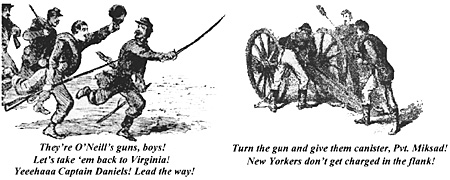 During the early '90s, I had the privilege of playing in the great Johnny Reb games that John Hill brought to the HMGS-East conventions. At each successive con, John would bring a slightly updated version of JR III to playtest, while this led to some confusion, we were all excited to see the streamlining taking place that enabled faster play with larger forces.
During the early '90s, I had the privilege of playing in the great Johnny Reb games that John Hill brought to the HMGS-East conventions. At each successive con, John would bring a slightly updated version of JR III to playtest, while this led to some confusion, we were all excited to see the streamlining taking place that enabled faster play with larger forces.
One thing present in the early test versions was that the status of the loser in a charge was determined by the difference between the two modified Impact dice-down rolls. So, I was disappointed to see in the final JRIII rules that the charge loser's status came from a separate dice-roll that took no account of the impact modifiers. When I asked John about this, he said that many playtesters had told him that coming up with the difference in the modified dice-rolls was too difficult. I could not understand this, as, to me, the hard part was tallying all those impact modifiers to begin with. I thought it a shame to throw away those modifiers (ones that you had to figure anyway to see who wins the charge) and hang the results on a dice-roll that had nothing to do with the situation going into the charge.
It is unlikely that a disordered, down a stand, green regiment (impact mod. +10) can win a charge against an elite reg. in-line with a officer (impact mod. +1), but if green rolls snake-eyes and elite rolls boxcars, that is exactly what happens. This is fine and part of the uncertainty of combat, but it is unfair to expose the elite reg. to the same chance of running off the table, as the green reg. would have if the situation were reversed.
For those of you who think that the results of a charge should be tied to the status of those participating, I submit a Charge Impact Results Table, where the outcome of a charge is determined by the final impact dice-down difference. The averaging effect of the dice tends to push the difference toward plus-or-minus small numbers, so use of the table should result in fewer melees. Another effect of using the table is that more thought must be given to ordering very unequal charges. On average, the loser with a big impact difference will take greater damage (stand loss) than with the random dice-roll in the JRIII charge procedure.
Most of the JR gaming that I do is at the HMGS-East conventions, and one thing that I noticed that was almost always forgotten, even in the rules author's games, was the after-charge two dice volley. In an effort to make up for this, I "tacked-on" some single figure losses around the 0 difference (melee) point as those impacts represent the harder fought, longer before break-off charges. If your group always remembers to do the after charge volley, ignore those Figure losses.
Charge Impact Results
Dice Difference
Defender wins by
- 12+ Attacker picks up
10,11 Attacker routs, loses 2 stands
8,9 Attacker routs, loses 1 stand
6,7 Attacker routs
5 Attacker retreats 1D6 Shaken and Disordered
3,4 Attacker retreats 2D6 Shaken and Disordered
2 Attacker retreats 1D6 Disordered (Loses 1 figure)
1 Attacker retreats 2D6 Disordered (Loses 1 figure)
Draw 0 Melee
Attacker wins by
- 1 Charge Stops. Defender retreats 1D6 Disordered (Loses 2 figures)
2 Charge % remaining distance. Defender retreats 2D6 Disordered (Loses 2 figs)
3,4 Charge full distance. Defender retreats 2D6 Shaken and Disordered (Loses 1 figure)
5 Charge full distance. Defender retreats 1D6 Shaken and Disordered (Loses 1 figure)
6,7 Charge full distance. Defender routs.
8,9 Charge full distance. Defender routs, loses 1 stand.
10,11 Charge full distance. Defender routs, loses 2 stands.
12+ Charge full distance. Defender picks up.
(Loses "x" figures) - substitutes for the After-Charge Volley.
Back to Table of Contents -- Charge! # 2
Back to Charge! List of Issues
Back to MagWeb Master Magazine List
© Copyright 2003 by Scott Mingus.
This article appears in MagWeb.com (Magazine Web) on the Internet World Wide Web.
Other articles from military history and related magazines are available at http://www.magweb.com